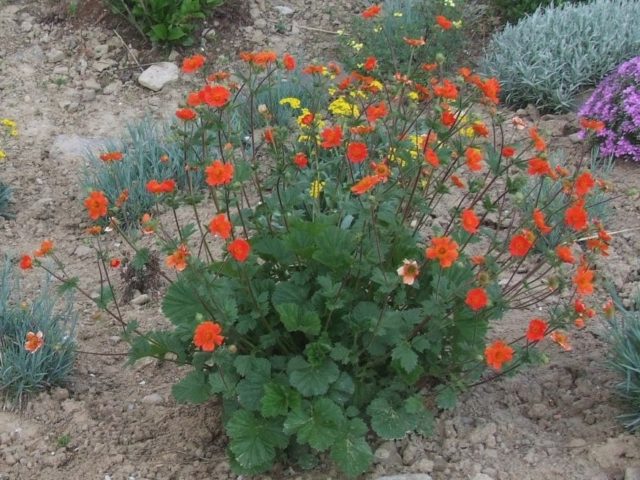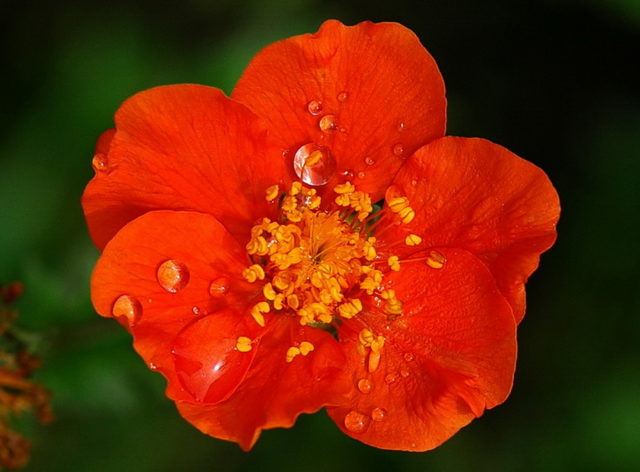Content
Bright red gravilate (Geum coccineum) is a herbaceous perennial from the Rosaceae family. Its homeland is the southern regions of Europe, the Balkan Peninsula, Turkey, the Caucasus. It grows in meadows, including alpine meadows, fields, less often in forests. Due to its high decorative properties and unpretentiousness, the flower has gained popularity among gardeners and landscape designers around the world. It is not difficult to grow bright red geum on your site if you adhere to the basic rules of agricultural technology.
Description of bright red gravilat
The plant is undersized, reaches a height of 25-30 cm, grows in diameter up to 40 cm. Bright red gravilat has a powerful single rhizome that goes deep into the soil. Each bush consists of several creeping shoots, the color of which ranges from green to purple-brown. Stems branch, releasing long lateral ones, small leaves grow at the joints.
Leaves resemble strawberry in shape - rounded, with denticles at the edges, tripartite. Soft, slightly folded, covered with a short velvety pile top and bottom. Collected in a socket in the root area. The color is malachite, bright green. Large, length is 20 cm.
Gravilat bright red forms buds at the tops of the shoots. The inflorescences are in the shape of a panicle; there can be several flower buds on one brush. Flowers are deep red, scarlet, simple or semi-double. The petals have a glossy sheen, the edge is wavy. The core is large, with bright yellow stamens. The flowering period is May-August.

From a distance, the flowers of gravilata are bright red, very reminiscent of poppies.
Description of the bright red gravilat Borisii
The Borisiy variety is distinguished by the highest decorative qualities, it is one of the tallest. The height of the bush is from 40 to 60 cm. The flowers reach 5 cm in diameter. The color is scarlet with an orange tint, the stamens are sunny golden, long. Juicy, green leaves grow up to 25 cm long. The flowering period is from late June to August. Gravilat bright red Borisy prefers sunny and slightly shaded areas with well-drained, fertile soils.

Gravilat bright red Boris is one of the leaders in popularity among Russian flower growers
Application in landscape design
Bright red gravilat is one of the most favorite flowering perennials by gardeners. The decorative garden flower is suitable for mono and group compositions. A short, profusely flowering plant with evergreen leaves, suitable for framing paths, swimming pools, artificial reservoirs and creating living borders.
Organically, gravilata bushes of bright red look on a green lawn and individual flower beds. They are planted in rock gardens and rockeries. They decorate front gardens and flower beds with their help. They create wonderful landscape compositions, combining with other flowering and evergreen plants. These can be dwarf conifers, mosses, low grasses, as well as flowers - forget-me-nots, cornflowers, phloxes, carnations, bells, saxifrage, primroses.

Gravilat bright red looks great on an alpine slide with other creeping and low-growing plants
Breeding features
Decorative, varietal gravilat bright red can only be propagated by dividing the bush. An adult overgrown mother bush must be carefully dug up and separate the rosettes along with part of the rhizome. "Children" are planted in fertile, well-moistened soil, immediately to a permanent place on the site. In order for the separated parts of bright red gravilat to take root well, the rhizomes can be treated with Kornevin solution. After 2 years, "babies" become fully formed adult bushes, delighting with abundant, bright flowering.
Planting and care rules
Gravilat is bright red, with all its splendor, quite unpretentious. It does not require special skills or frequent feeding from the owners of the site. Novice gardeners can also cope with the cultivation of this decorative handsome man.
Timing
Bright red gravilat seeds can be planted in open ground in April-early May, when the snow has melted and the soil is sufficiently warmed up. Seedlings are sown in February-March, depending on the climatic zone. Young plants can be placed in their permanent habitat only when the threat of soil frost has passed. As a rule, this is mid-May.
Having passed natural hardening, in the spring the bright red gravilat will delight with friendly, strong shoots.
Site selection and soil preparation
Gravilat bright red loves sunny, open places. But even in partial shade, under the crowns of trees or next to shrubs, it also feels comfortable. Prefers dense, well-moistened, but by no means swampy soils. If the site is low, it is regularly flooded, then raise the planting zones 30-60 cm above the soil level and ensure good drainage. A loam with a neutral or slightly alkaline reaction is best suited, to which organic fertilizers and ash should be added.
If the soil is heavy, clayey, then when digging a site, it is necessary to add coarse sand to loosen it. Add compost or well-rotted humus. If the soil is acidic, you can add slaked lime or dolomite flour. Gravilat bright red responds well to watering with a diluted mullein.
Landing algorithm
It is necessary to plant gravilat with bright red seedlings in prepared holes, which are 1.5 times larger than the root ball in size. Gently add fertile soil, and slightly crush. The root collar is positioned at soil level. The distance between the bushes is 25 cm.
The prepared seeds are sown in small holes or furrows, at a distance of 16-25 cm from each other, with a depth of 20-30 mm. After that, the ground must be leveled and watered well. Later, the grown bright red gravilat is thinned out, removing weak specimens in order to prevent thickened plantings.
Watering and feeding schedule
Gravilat bright red does not tolerate stagnation of water in the soil, so it must be watered sparingly. Depending on weather conditions, adult bushes are irrigated at the root once a week, preferably in the evening, when the sun is already leaving. In a rainy summer, additional watering is not required, and in a drought, if the soil dries up rapidly, daily watering will be useful.
If the soil is fertile enough, then feeding with complex mineral fertilizers or organic matter is required only 2 times per season - in the spring and after the beginning of flowering. On depleted soils, autumn dressing is added. Bright red gravilat responds well to the introduction of ash and liquid vermicompost.
Pruning
To make the bright red gravilat look neat, shoots that are too long must be pinched as they grow.For more intense flowering, old buds should be cut off.

Correctly formed gravilat bright red is a neat green hemisphere with lush flowers
Wintering
Gravilat bright red belongs to the 4th class of frost resistance, and feels great in the northern regions of Russia, in the mountains. It hibernates without additional shelter if there is sufficient snow cover. If the forecast promises a frosty and little snowy winter, the site can be covered with spruce branches, chopped straw or dry leaves.
Diseases and pests
Gravilat bright red is distinguished by increased resistance to fungal, viral and bacterial diseases. A perennial is rarely attacked by insect pests.
With waterlogged soil or close underground waters, bright red geum can get sick with root rot. The affected bushes must be dug up and burned, the rest of the plantings must be treated with a fungicide.
In drought, in case of insufficient watering, weakened bright red gravilat is susceptible to attacks by spider mites. The methods of pest control are quite simple: it is necessary to treat the leaves and stems with a suitable insecticide, revise the irrigation schedule.
Conclusion
Bright red gravilat is a magnificent decorative perennial with openwork, bright green leaves and large flowers. It attracts attention, looks great in landscape compositions. The combination of scarlet gravilata with pale blue and blue undersized flowering species and rich greenery of herbs, spruces and pines is especially good. Geum bright red is not capricious, almost does not require attention from the gardener. You only need timely watering and feeding 1-2 times over the summer. It is the external beauty and amazing unpretentiousness that determined the popularity of this plant among flower growers around the world.








